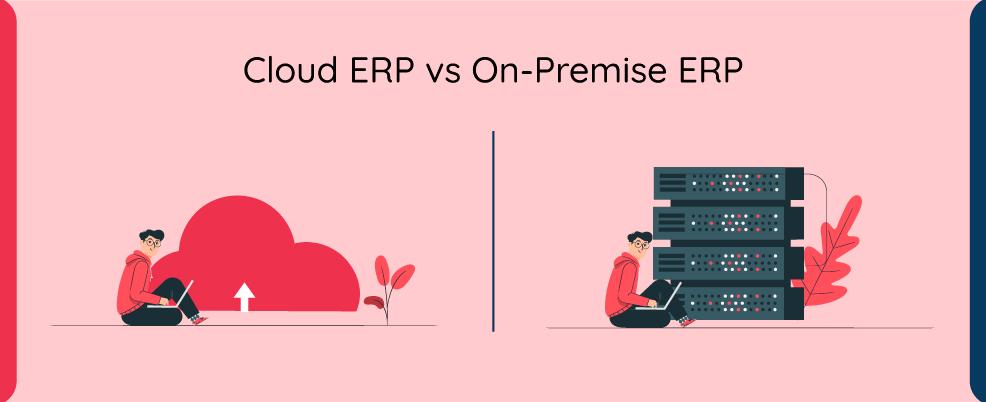When choosing a new enterprise resource planning (ERP) system, one of the most important considerations will be whether to go with on-premise ERP or cloud ERP. Cloud-based ERP solutions are becoming more popular than ever. Almost every ERP vendor now provides some type of cloud deployment option, and some have abandoned their on-premise ERP services entirely.
However, there are various reasons why a small or midsize organisation could pick a traditional on-premise ERP system, which was the standard in the ERP sector until recently. Which one is best for your company? Only you can make that decision, but this breakdown of the advantages and drawbacks of each should help.
What distinguishes the two?
Ownership Costs
On-premise ERP systems often necessitate significant upfront and continuing expenses to acquire and operate the software as well as the accompanying equipment, servers, and facilities required to run it. If your firm does not have a big or experienced IT workforce, you may need to invest more time and money in hiring and training new employees. More significantly, on-premise systems need that your IT team dedicate a considerable amount of their time and resources to assuring your system is operational when you need it, including server room maintenance and hardware upkeep. When it comes time to upgrade your ERP system, IT must reinstall the system across the various user PCs and re-implement numerous modifications and integrations that your company installed on earlier software.
Initial expenses for cloud-based ERP are often substantially lower because you just configure the software to your needs and then access it via your computer’s internet connection. The cloud ERP provider hosts and maintains all of your IT infrastructure, ensuring that the system is always up and running, that your data is safe, and that product upgrades are seamlessly rolled out to your solution without disrupting any previously established changes. Finally, all of this frees up your IT professionals to focus on innovating and helping the business expand more successfully, rather than spending an inordinate amount of time maintaining and administering your on-premise systems. Planning and managing cash flow may be made considerably simpler by using the cloud ERP’s predictable, pay-as-you-go subscription model.
System Upgrades and Enhancements
On-site ERP software can be changed; however, these adjustments are bound to your present software deployment and are difficult to re-implement with future versions. Your IT staff will have to start from beginning when you upgrade since any modifications you had previously done will be lost when your ERP provider releases new product upgrades and advancements. That is the primary reason why many businesses resist updating their on-site ERP software and instead continue to operate on obsolete technology. In fact, two-thirds of mid-sized organisations are using out-of-date ERP software.
Cloud ERP systems, on the other hand, are constantly upgraded by the provider, ensuring that you are always running the most recent, powerful version of your ERP software. Because today’s premier cloud applications are built on a cloud platform, your previously developed modifications and integrations are immediately carried forward when the solution is upgraded, requiring no further expenditure.
Enhanced System Accessibility and Efficiency
Cloud ERP generally outperforms on-premise systems. Cloud software architecture is built from the bottom up to maximise network performance, which can result in higher application uptime than traditional on-premise ERP systems. Cloud-based ERP also provides optimal performance that may be tailored to your specific requirements. If your organisation experiences a surge, cloud ERP immediately adapts and dynamically provides more resources to accommodate the upsurge.
It’s also worth mentioning that a cloud-based ERP solution delivers real-time data that can be accessible through the Internet at any time and from any location. That means your employees may access correct information on computers, smartphones, and tablet devices while travelling or telecommuting—all without additional setup fees or continuing charges.
Deployment Speed
Every ERP implementation involves meticulous planning and takes time, but when it comes to deployment speed, cloud ERP has definite advantages. Because cloud ERP requires no new hardware, your company will save time acquiring and implementing IT infrastructure. You can simply roll out cloud ERP across numerous locations, subsidiaries, and divisions while avoiding the costs associated with those rollouts. These changes can add up to considerable time savings if you use a cloud-based ERP system: Cloud ERP installations typically take 3-6 months, as opposed to the 12 months it takes to establish an on-premise solution.
Cloud-based ERP solutions are also easier to expand, allowing you to add additional users as your company grows. On-site ERP solutions do not provide the same level of flexibility—in order to provide more employees access to an on-site system, extra hardware is sometimes required.
Conclusion
For today’s global and dynamic market, ERP is an essential component of creating efficient, robust business operations. Businesses that analyse and enhance their existing systems and procedures might gain a competitive edge and become more adaptable as their markets and industries change. After you understand the needs and benefits of each type of ERP system, you can decide which is best for your company.


